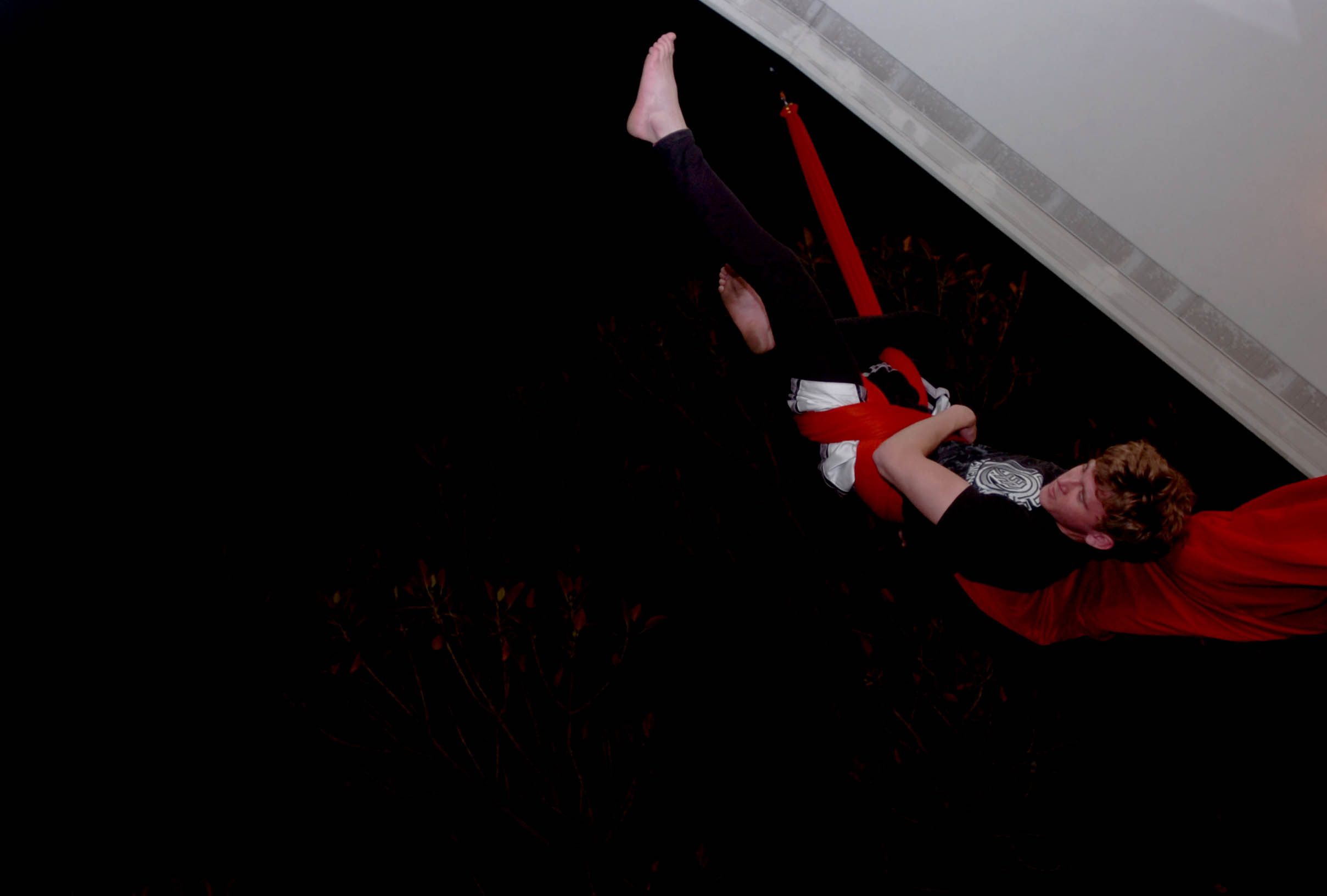Andrew Blankfield hoists himself up onto the white ply rope.
Using his toes as grips, he climbs with the dexterity of a spider monkey toward the top, pausing to flip upside down and wrap the rope in multiple loops around his waist and thighs.
A moment later, the first-year math student is unraveling artfully downward against an unconventional backdrop: Powell Library. The rope is rigged not to the roof of a circus tent or gym ceiling, but to a tree on Bruin Walk.
Aerials are a relatively new presence on the UCLA campus, and the set of silks purchased by the recreational gymnastics supervisors drew high interest while hanging in Yates Gymnasium in the John Wooden Center. But without an official evaluation of the activity on record, Wooden officials concerned for user safety asked aerialists in early February to stop practicing in the gym. The fabric silks have been taken down while the John Wooden Center researches the possibility of a silks, rope and trapeze class for fall 2010.
With a decision pending, a small but determined group of amateur and professional students has moved operations outdoors.
“It’s more out of desperation than rebellion,” said Shauna Klebesadel, a first-year French student and beginning aerialist. “We cannot live without this.”
Students walking to and from class stare at the circus-like acrobatics with open mouths. Cameras click furiously. The extra curious approach the aerialists with questions like, “Is that really hard?” “Do you have like a circus community?” and, most commonly, “Can I join?”
To the latter, the answer is no ““ at least for now. These aerialists are not members of a formal UCLA student group, but rather a group of friends with a shared passion. But Klebesadel, Blankfield and several others who want to regain gym privileges have pushed since February for aerials to become a permanent part of the Wooden Center program.
“We just need a place to practice,” first-year English student and beginning aerialist Lisa Ciuffetti said.
The motion reflects the growing popularity of aerials for both artistry and exercise.
“It’s a great workout,” said Terri Youngblood-Kinsley, a supervisor for recreational gymnastics. “There’s high interest ““ there definitely should be a class.”
Rudy Figueroa, the assistant director of student recreation venues at the John Wooden Center, called the suspension of open recreation privileges “a pause for safety.”
“(We want) to see that if we do move forward, it’s not just a trend but something sustainable,” he said.
A meeting during spring break brought together students, Wooden Center officials and Trapeze School New York (TSNY), which runs a local trapeze school on Santa Monica Pier and has offered to provide instructors. The meeting was productive, Figueroa said.
“(UCLA) is very smart in wanting to vet new activities for students,” said Jonathon Conant, president and cofounder of TSNY. “Aerials are fairly new to colleges like UCLA.”
Youngblood-Kinsley said that she and her husband Brian Kinsley first purchased and hung silks two years ago in Yates Gymnasium. Students like Jayme Darling, a recent UCLA alumna who has been involved in aerial arts for 20 years, jumped at the opportunity to practice for free on campus.
Darling said that local venues offering the appropriate facilities are both unaffordable and inaccessible to most students.
“It costs an arm and a leg,” said Darling, who currently coaches silks and hoop aerials at a private school in Santa Monica. “If there is a class for newbies to try it out, I’d love that.”
Circus shows, nightclubs, high-end mansion parties and Renaissance fairs regularly showcase aerial performances. In an indication of a trend reaching a new level, aerial silks also appeared at Coachella Music Festival and at this year’s Grammys, during artist Pink’s rendition of “Glitter in the Sky.”
“As with any activity, there needs to be some level of supervision ““ making sure that what students are doing is researched and that they’re safe,” Figueroa said.
The open gymnastics coaches are not certified in aerialist training, he said, and the ceiling bar supporting the silks has not been officially cleared to hold weight.
A tree trunk may be even more questionable, but Klebesadel insists that the equipment the group has purchased is top-notch. The gadgets that accompany the rope, like carabiners and tubular webbing, are professional and pricey. The swivel, a small black piece that lets the rope turn without interference, alone cost $60.
“We haven’t skimped on the equipment, because safety is our top priority,” Klebesadel said.
Without the mats and crash pads of a gym environment, the group has restricted itself to the basics when using trees or other urban settings. The worst injuries so far have been burns from the rope and fabric.
“We don’t try anything new, we only work on what we learned prior with specialists and professional aerialists,” Klebesadel said.
The afternoon of practice wound down with Ciuffetti circling the rope and critiquing Blankfield’s positioning, and fourth-year and professional aerialist Genie Cartier calling up, “Keep your head tucked.”
Klebesadel sat on the grassy hillside and watched with a smile.
“I don’t want to lose sight of this,” Klebesadel said. “None of us do.”
